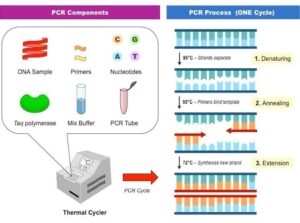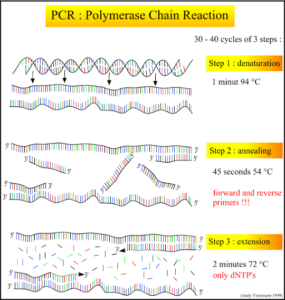Back to: MICROBIOLOGY 500 LEVEL
Welcome to class!
Hello my super brilliant microbiology student! It’s always a pleasure to see your commitment to learning. You’ve been doing wonderfully, and today’s lesson is something every 21st-century scientist must know. We’re going to talk about one of the most important techniques in modern biology—PCR, or Polymerase Chain Reaction. Trust me, by the end of this class, you’ll understand how scientists can make millions of copies of DNA from just a tiny amount—like multiplying a single page into a whole stack in minutes!
Principles And Stages Of PCR
Let’s begin with a simple question: what if NECO needed to mark your Biology answer script, but your paper was missing? Now imagine if a photocopy could be made from even a torn piece of your original sheet. That’s what PCR does—it amplifies or copies specific parts of DNA, even if it’s just a small trace!

PCR is a lab method developed by Kary Mullis in 1983 that allows scientists to make millions of copies of a specific DNA segment. It is used in medical diagnosis, forensic science, research, and even in detecting viruses like COVID-19.
Principles of PCR
PCR is based on the principle of DNA replication—the natural process by which cells make copies of their DNA.
To carry out PCR, three main components are needed:
Template DNA – the DNA that contains the region you want to copy.
Primers – short single-stranded DNA pieces that attach to the start and end of the region to be copied.
DNA polymerase – an enzyme that builds the new DNA strands. A special heat-resistant enzyme called Taq polymerase is commonly used.
Nucleotides (dNTPs) – the building blocks used to make the new DNA strands.

PCR takes place in a machine called a thermocycler, which changes the temperature in steps to drive the reaction.
Stages of PCR
PCR works in three main stages, repeated for about 30–40 cycles:
Denaturation (94–96°C)
The double-stranded DNA is heated to separate it into single strands—just like unzipping a jacket.
Annealing (50–65°C)
The temperature is lowered so the primers can attach (anneal) to their matching sequences on the single-stranded DNA.
Extension (72°C)
This is where Taq polymerase adds nucleotides to the primers, building a new strand of DNA, just like a photocopy machine printing a page.
With each cycle, the amount of DNA doubles. So from one copy, you can get millions in just an hour!

Real-life Nigerian example: Think of a tailor in Abuja given a pattern for one kaftan. By the end of the day, he’s sewn 100 identical kaftans. PCR is like that—it takes a design (template DNA) and makes many copies quickly!
Why PCR Is Important
PCR is used in:
Diagnosing diseases (e.g. malaria, HIV, COVID-19)
DNA fingerprinting in forensic science
Paternity testing
Research in genetics and molecular biology
Summary
- PCR is a method used to make many copies of a specific DNA sequence.
- It involves three stages: denaturation, annealing, and extension.
- PCR is based on the natural process of DNA replication, using primers and Taq polymerase.
- It is widely used in medicine, forensics, and research.
Evaluation
- What is the full meaning of PCR?
- Name and explain the three stages of PCR.
- Why is Taq polymerase important in PCR?
Wow! You’ve just unlocked one of the most powerful tools in modern biology. PCR is the reason doctors can quickly diagnose infections, scientists can study DNA, and even crime scenes can be solved. You’re learning to think like a real-world scientist, and Afrilearn is proud to support your journey. Keep believing in yourself—you’re built for greatness! See you in the next lesson!
